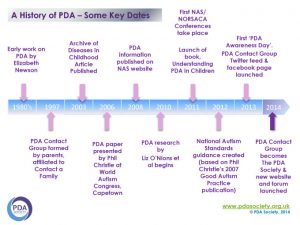
About PDA
People with Pathological Demand Avoidance Syndrome (PDA) will avoid demands made by others, due to their high anxiety levels when they feel that they are not in control.
PDA is increasingly recognised as part of the autism spectrum.
PDA, first described by Elizabeth Newson during the 1980s as a pervasive developmental disorder distinct from autism, is increasingly becoming recognised as part of the autism spectrum. It is a lifelong disability and, as with autism and Asperger syndrome, people with PDA will require different amounts of support depending on how their condition affects them.
The central difficulty for people with PDA is their avoidance of the everyday demands made by other people, due to their high anxiety levels when they feel that they are not in control. Many children avoid demands to some extent, but children with PDA do so to a far greater level than is considered usual. This is why it is called pathological.
People with PDA tend to have much better social communication and interaction skills than other people on the spectrum, and are consequently able to use this ability to their advantage. They still have real difficulties in these areas though, usually because they need to control the interaction. They often have highly developed social mimicry and role play, sometimes becoming different characters or personas.
The main features of PDA are:
- Obsessively resisting ordinary demands
- Appearing sociable on the surface but lacking depth in their understanding (often recognised by parents early on)
- Excessive mood swings, often switching suddenly
- Comfortable (sometimes to an extreme extent) in role play and pretending
- Language delay, seemingly as a result of passivity, but often with a good degree of ‘catch-up’
- Obsessive behaviour, often focused on people rather than things.
Often in cases of PDA there will have been a passive early history, but this is not always the case. It is believed that there may be neurological involvement in some cases, with a higher than usual incidence of clumsiness and other soft neurological signs.
Other children on the autism spectrum can display one or more of these features but when many occur together it is helpful to use the diagnosis of PDA because things that help people with autism or Asperger syndrome do not always help those with PDA.
People with PDA can be controlling and dominating, especially when they feel anxious and are not in charge. They can, however, be enigmatic and charming when they feel secure and in control. Many parents describe their child with PDA as a ‘Jekyll and Hyde’. It is important to recognise that these children have a hidden disability and often appear typical to others. Many parents of children with PDA feel that they have been wrongly accused of poor parenting through lack of understanding about the condition. These parents will need a lot of support themselves, as their children can often present severe behavioural challenges.
People with PDA are likely to need a lot of support into their adult life. Limited evidence so far suggests that the earlier the diagnosis and the better support that they have, the more able and independent they are likely to become